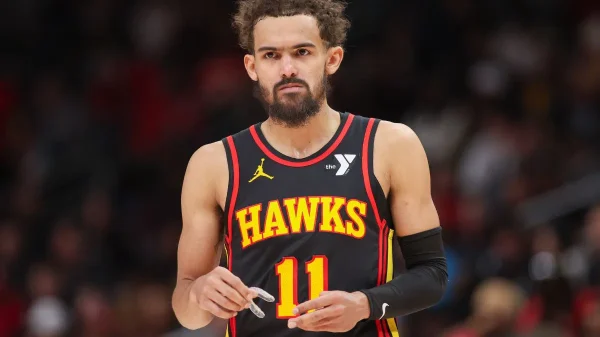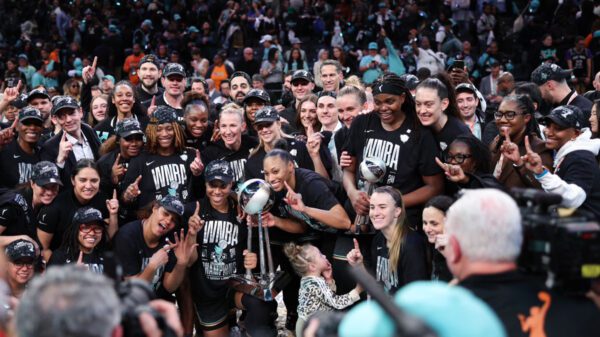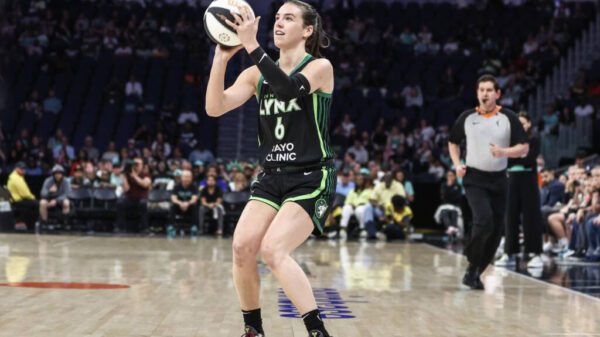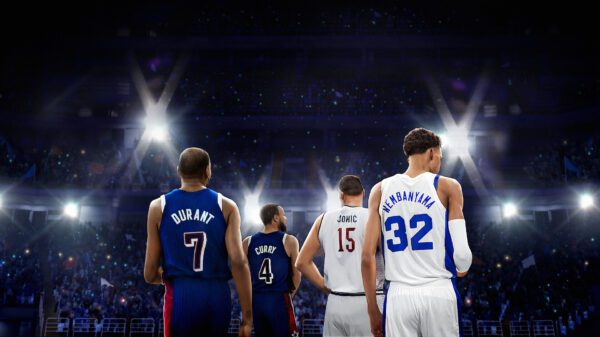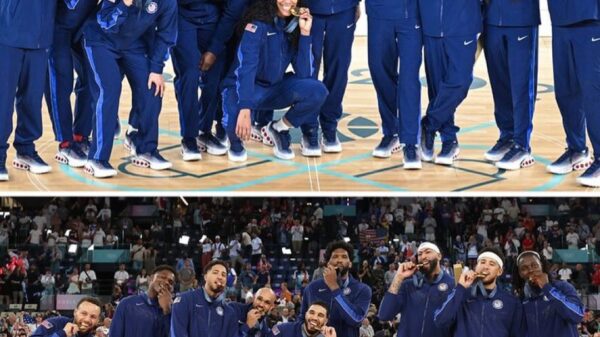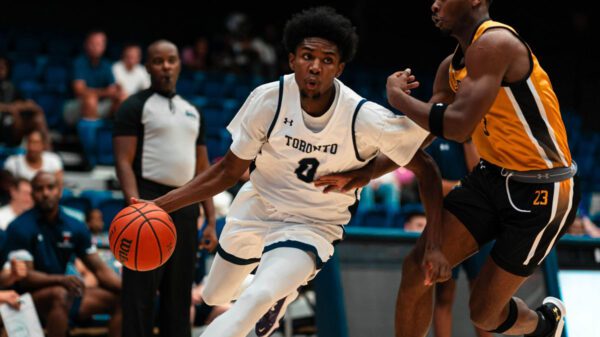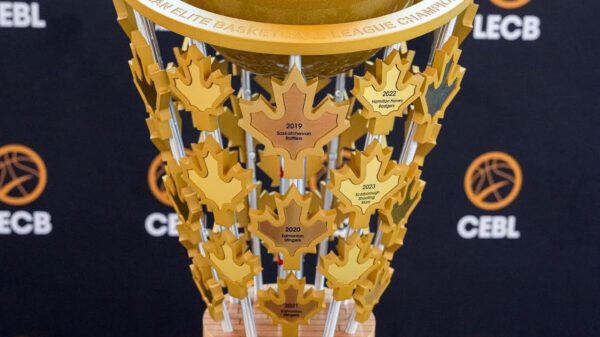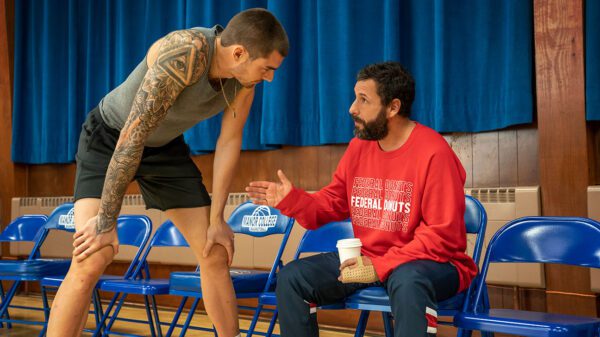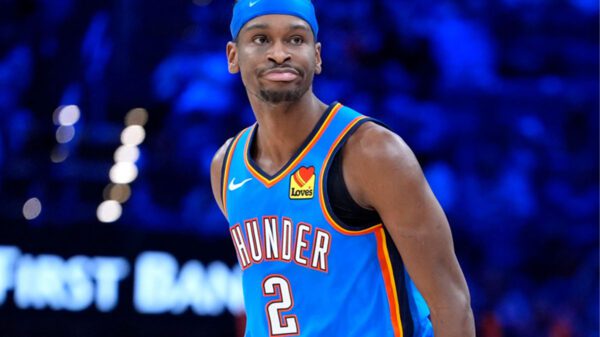A century of Canadian excellence in NCAA basketball
The story of Canadian basketball in the NCAA dates back to the early 1920s, marking the beginning of a rich tradition that continues to this day.
Frank Sibley II emerged as a trailblazer, becoming one of the first documented Canadians to compete in NCAA Division I basketball. Born in Nova Scotia and raised in Gary, Indiana, the six-foot-two Sibley wore the cream and crimson of the Indiana Hoosiers from 1923 to 1927, paving the way for generations of Canadian talent to follow.
The 1930s saw the emergence of a significant Canadian presence at the University of Detroit Mercy, largely due to its strategic location across the Detroit River from Windsor, Ontario. This geographical proximity created a natural pipeline for Canadian talent through a short bridge crossing.
Bill Butcher, Frank Dowd, and Harry Shanahan were among the first to cross the border, followed by Gordon Aitchison, establishing one of the earliest and most enduring cross-border basketball relationships in NCAA history.
Pete Newell left an especially lasting impact on the game. After competing for the Loyola Marymount Lions (1935-39), he would become one of the most influential basketball minds in the sport’s history.
Newell’s coaching career reached unprecedented heights as he became one of only three coaches to achieve basketball’s triple crown: winning an NIT Championship (1949 with San Francisco), NCAA Championship (1959 with California), and Olympic Gold Medal (1960 with Team USA).
The 1940s marked a watershed moment when Ernie Vandeweghe achieved an unprecedented milestone, becoming Canada’s first NCAA All-American in 1948-49. This historic achievement demonstrated that Canadian players could not only compete but excel at the highest levels of collegiate basketball, setting the stage for future generations.
From Naismith to Now: Bridging the Historical Gap
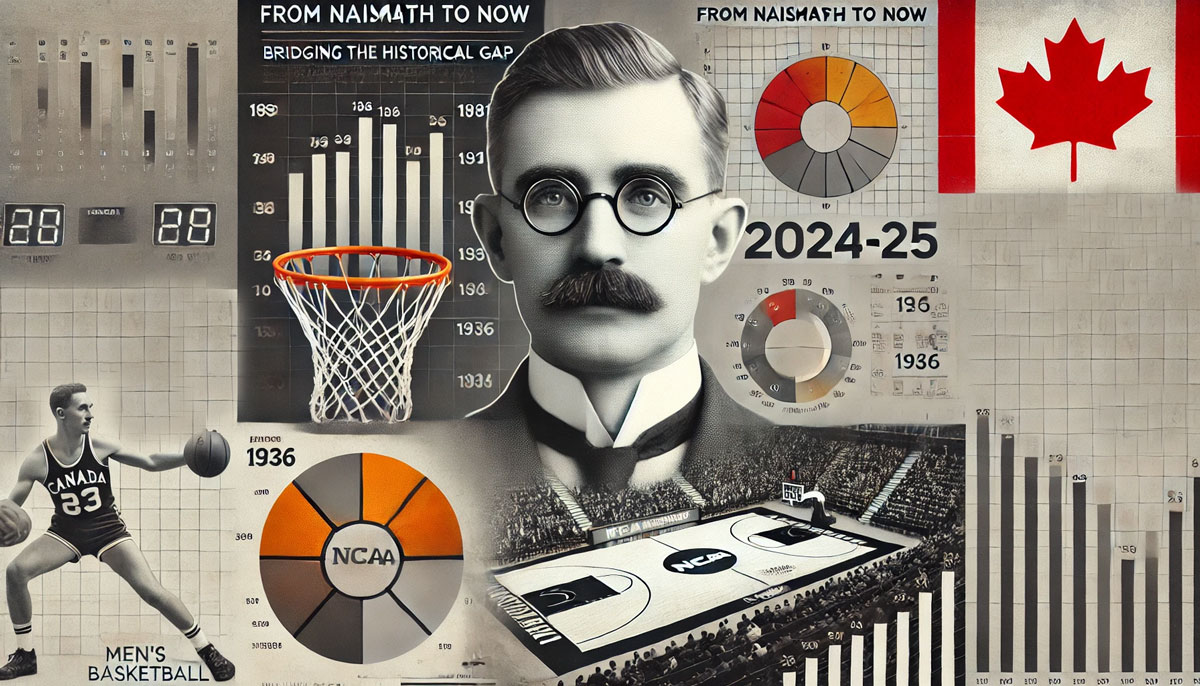
It’s a striking irony that while Canada gave the world basketball through James Naismith’s invention in 1891, won silver in the first-ever Olympic basketball tournament in 1936, and hosted the first-ever NBA game—between the Toronto Huskies and New York Knicks at Maple Leaf Gardens in 1946—the nation’s historical basketball record-keeping has been remarkably incomplete.
While the NBA, FIBA, and Olympic statistics of Canadian players have been largely preserved due to technological advances and the relatively small number of Canadians reaching the professional ranks, the same cannot be said for the collegiate level.
However, the recent surge in Canadian basketball’s global prominence has sparked renewed interest in piecing together the nation’s rich basketball history. This renewed focus has resulted in more precise editorial coverage and recognition of significant milestones.
We’ve witnessed history unfold as our nation’s players have claimed national NCAA statistical crowns in rebounding and scoring, and set new Canadian benchmarks in triple-doubles, assists and steals.
The 2024-25 Season: A New Chapter
As we embark on the 2024-25 NCAA basketball season, Canadian representation in Division I men’s basketball has reached unprecedented heights.
A record-breaking 170 Canadian student-athletes are competing across NCAA men’s programs, along with an additional 135 in women’s teams, marking the highest number in history and further cementing Canada’s status as the leading international producer of NCAA Division I talent.
All eyes in the Canadian basketball community will be on Kitchener, Ontario native Will Riley, a freshman at Illinois who is expected to be a first-round pick in the 2025 NBA Draft.
Riley is considered the most promising candidate to boost Canada’s international presence in the NBA and to continue the country’s streak of having players selected in the NBA Draft for the fifth consecutive year and ten out of the past fifteen years.
The emergence of junior guard Xaivian Lee from Princeton and the consistency of Montreal’s Jahmyl Telfort, both of whom tested the NBA Draft waters last season, along with the elite playmaking abilities of Ryan Nembhard, could result in Canada once again having multiple draft picks come June 2025.
From a milestone perspective, Telfort, entering his fifth and final season, is expected to be the latest Canadian to reach the exclusive 2000+ point career club.
Nembhard, who set the single-season assists record, is on the verge of breaking the all-time Canadian NCAA career assists record. He also has the potential to become the first Canadian player to average double-digit assists and lead the NCAA division I in assists. Similarly, on defence, Kellen Tynes is poised to become the all-time leader in steals.
Pay attention to head coach Dave Smart, now one of only two Canadian coaches in the NCAA, and the Pacific Tigers. Keep an eye on their versatile 6‑foot‑8 forward Elias Ralph and his significantly improved teammate Elijah Fisher.
Also worth watching is Santa Clara’s junior college transfer, Elijah Mahi. These dynamic players, alongside Nembhard, have the potential to earn spots on one of the West Coast Conference all-conference teams.
Meanwhile, Hasan Abdul Hakim is rising as one of college basketball’s hidden gems, showcasing impressive talent and versatility in multiple positions. Emanuel Sharp of the Houston Cougars, Aden Holloway from the Alabama Crimson Tide, and Vasean Allette at Texas Christian University (TCU) have all made significant contributions on the stat sheet.
Additionally, Malachi Davis, Taryn Todd, Josh Bascoe, TJ Hurley, Jacob Holt, Bubu Benjamin, Marko Maletic Jamal Fuller and Tyson Dunn are all gearing up for standout seasons.
Overall, it’s set to be another thrilling season for Canadians in NCAA college basketball, with future draft prospects and the influence of Name, Image, and Likeness (NIL) opportunities continuing to shape the landscape.
2024-25 Canadian NCAA men’s basketball stats tracker – per game (subscribers only)
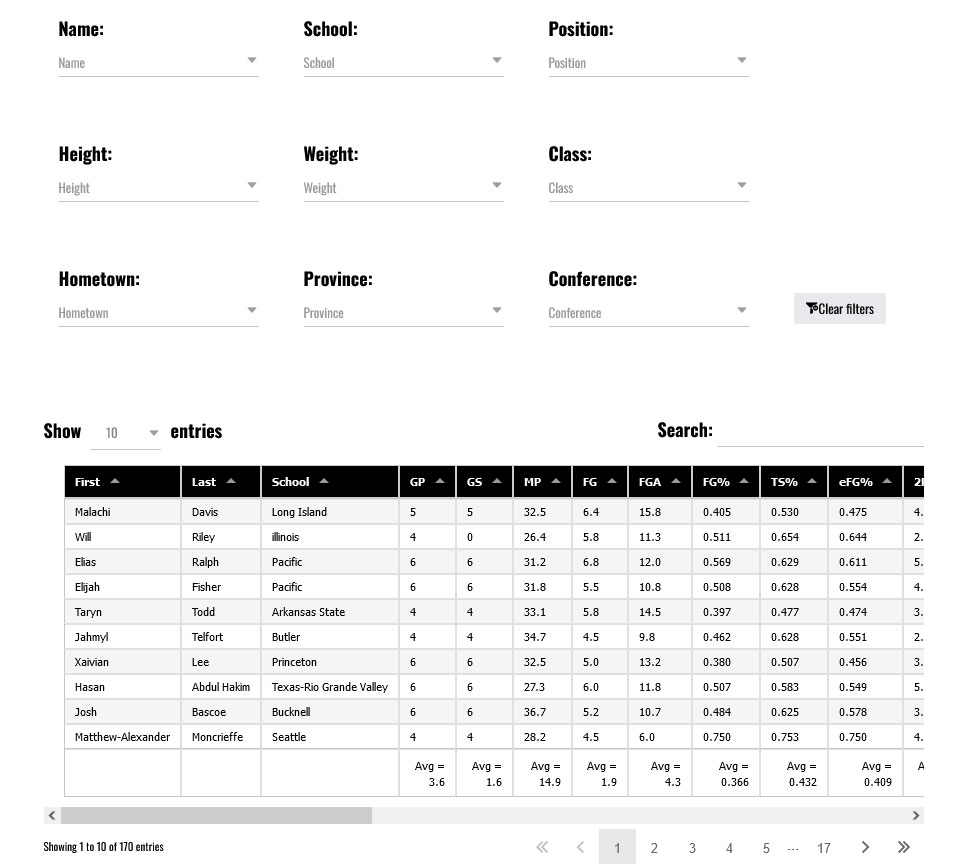
2024-25 Canadian NCAA men’s basketball stats tracker – Total minutes vs. points, rebounds, blocks (subscribers only)
Among the various methods to analyze per-game and total statistics, bubble charts emerge as one of the most effective visualization tools for interpreting complex basketball data.
Bubble charts excel at revealing player performance patterns by visualizing multiple statistics simultaneously. The minutes versus points, rebounds, and blocks chart, for instance, provides immediate insight into how a player’s scoring output correlates with playing time, while also showing their effectiveness as a rebounder and shot-blocker.
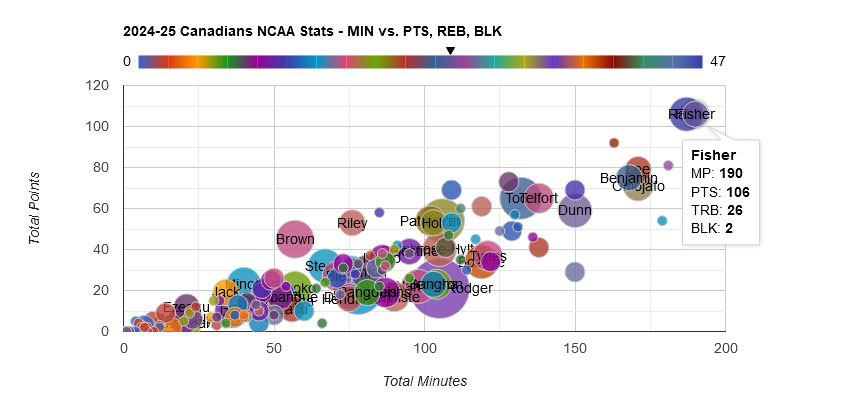
It also provides a clear visualization of the trend between minutes played and points scored, making it easier to identify outliers or players with exceptional scoring efficiency. Furthermore, bubble charts can reveal interesting patterns, such as players who can score efficiently in fewer minutes.
Efficient Scorers: Look for bubbles in the top-right corner with a smaller size. These players score many points in fewer minutes. High-Volume Scorers: Look for bubbles in the top-right corner, regardless of size. These players score many points and play many minutes. Rebounding Machines: Look for bubbles with darker colours (indicating more rebounds) in the top-right or bottom-right corners. Defensive Stoppers: Look for large bubbles, regardless of their position on the chart. These players are strong shot-blockers.
2024-25 Canadian NCAA men’s basketball stats tracker – totals (subscribers only)
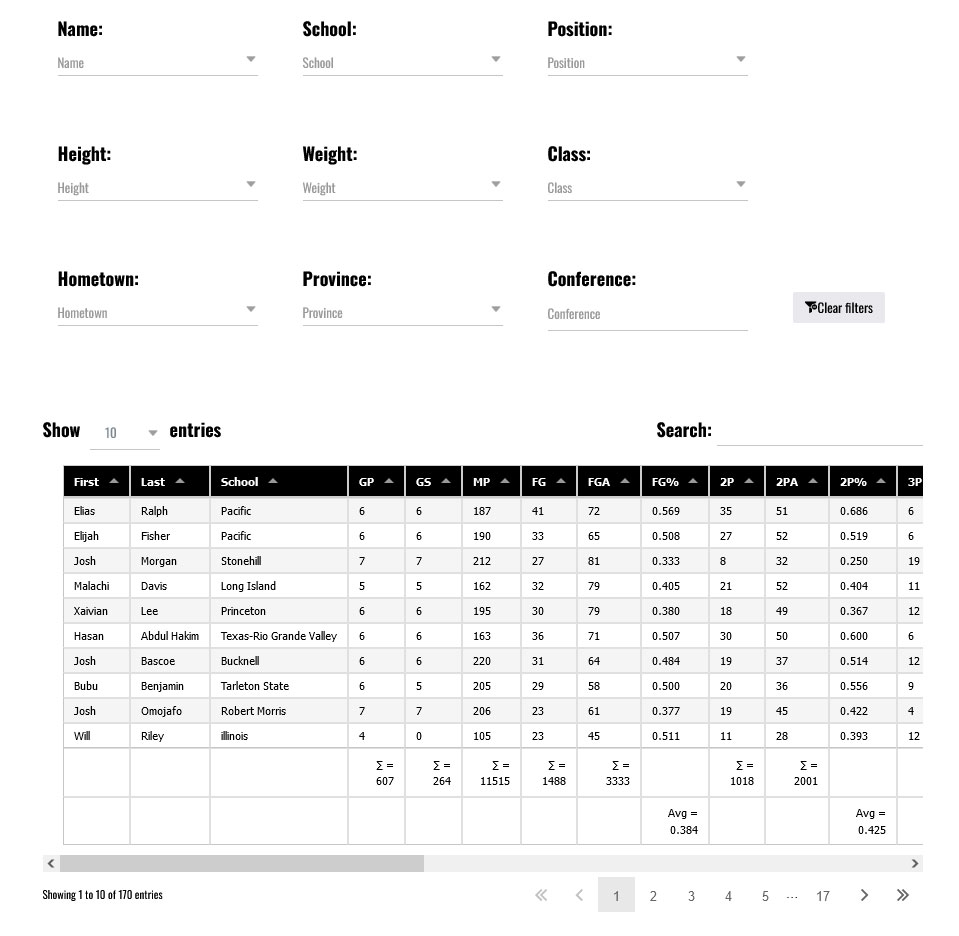
2024-25 Canadian NCAA men’s basketball stats tracker – Total minutes vs. assists, steals, turnovers (subscribers only)
Having identified elite scorers and rebounding specialists in our first bubble chart, this visualization shifts focus to the play-making and defensive elements of the game. By examining minutes versus assists, steals, and turnovers, we can uncover the players who excel in ball distribution and defensive disruption.
Here we once again utilize a bubble chart to effectively illustrate the relationship between playing time and play-making proficiency. The visualization of minutes versus assists, steals, and turnovers reveals how players balance court vision and defensive opportunism while maintaining ball security. This comprehensive view helps identify players who make the most of their minutes through impactful plays while avoiding costly mistakes.
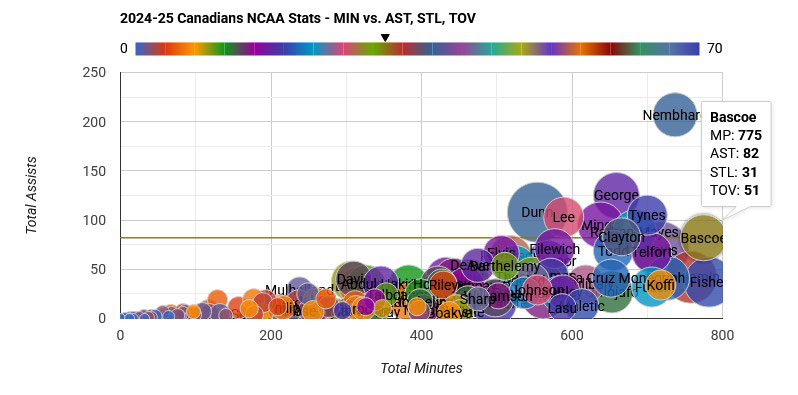
Elite playmakers: Look for bubbles in the top-right corner with darker colours, indicating players who consistently create scoring opportunities through high assist numbers. Defensive disruptors: Large bubbles show players with high steal totals, revealing those who excel at creating turnovers while limiting their own. Ball security specialists: Focus on smaller bubbles relative to playing time, identifying players who maintain low turnover rates despite significant minutes. Two-way facilitators: Find bubbles with balanced size and colour in the right portions of the chart, showing players who effectively combine assist generation with defensive steals.
2024-25 Canadian NCAA men’s basketball stats tracker – MIN, PTS, REB, AST, STL, BLK by class (subscribers only)
In the 2024–25 NCAA season, we have an expanded classification system that now includes redshirt designations. This granular approach provides better insight into player development, showcasing the depth and complexity of Canadian basketball talent across different stages of collegiate careers and indicates there isn’t much difference in terms of output between a redshirt freshman and a true freshman.
The senior class remains the cornerstone of Canadian NCAA performance, bringing unparalleled leadership and consistency to their respective programs.
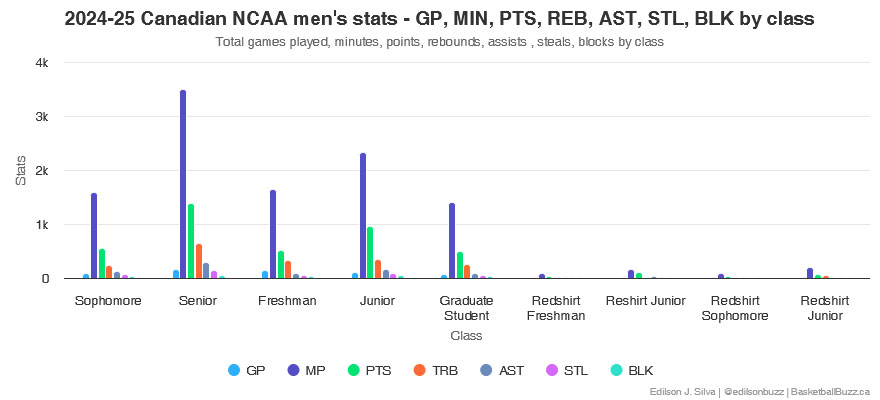
Significant attention will also be directed toward the freshman class. In addition to Riley, standout contributors include Babatunde Durodola, a dependable player and potential double-double threat from Temple, and Hermann Koffi, a six-foot-four guard who joins Stonehill College under Canadian head coach Chris Kraus.
Koffi is joined by graduate student Joshua Morgan, another Canadian guard standing six-foot-three. Together, they form a dynamic Canadian duo on Kraus’s Stonehill roster, with the Canadian-born coach bringing a unique perspective to developing homegrown talent in the NCAA.
The sophomore class production will be highlighted by Allette, Ethan Butler, and Bubu Benjamin. The junior class features Fisher and Lee, and has become a factory for strong junior college transfers, including Josh Omojafo, Mahi, Addison Patterson, and Davis.
2024-25 Canadian NCAA men’s basketball stats tracker – points by conference (subscribers only)
This season’s conference scoring data illustrates Canadian basketball’s continued global ascension. From the West Coast to the Northeast, Canadian players are actively reshaping NCAA basketball’s competitive landscape.
The West Coast Conference has emerged as the definitive Canadian scoring epicenter for the 2024-25 NCAA season. Representing approximately 8.3% of total Canadian scoring, the WCC’s nine Canadian players have disproportionately dominated the scoring charts. Four players in the conference consistently average double-digit points, transforming the WCC into a Canadian scoring playground.
The Northeast Conference (NEC) has established itself as a surprising powerhouse, accounting for 7.7% of all Canadian NCAA scoring. Leading the charge is Malachi Davis, whose scoring ability has been complemented by the consistent contributions of teammate Jamal Fuller. Their combined effectiveness has helped establish the NEC as a significant hub for Canadian talent.
The Mid-American Conference (MAC) has carved out its own niche, contributing 6.9% of Canadian scoring production. The conference showcases a balanced attack led by Tyson Dunn, while Trey Thomas and Ethan Butler provide additional offensive firepower, making the MAC one of the most reliable sources of Canadian scoring talent.

Not to be overlooked, the America East Conference (AEC) accounts for 6.0% of Canadian scoring, featuring several standout performers. TJ Hurley is enjoying his most productive collegiate season to date, while Kellen Tynes and Jayden Clayton have formed a dynamic scoring duo that has elevated the conference’s profile.
The Western Athletic Conference (WAC) presents perhaps the most exciting narrative of concentrated Canadian scoring talent. With three players—Abdul Hakim, Matthew-Alexander Moncrieffe, and Benjamin—averaging 15+ points per game, the conference has become a proving ground for Canadian offensive excellence.
The geographical diversity of these scoring contributions—spanning from the West Coast to the Northeast—demonstrates the broad impact of Canadian talent across the NCAA landscape. This widespread distribution reflects not only the quantity but also the quality of Canadian basketball development.





